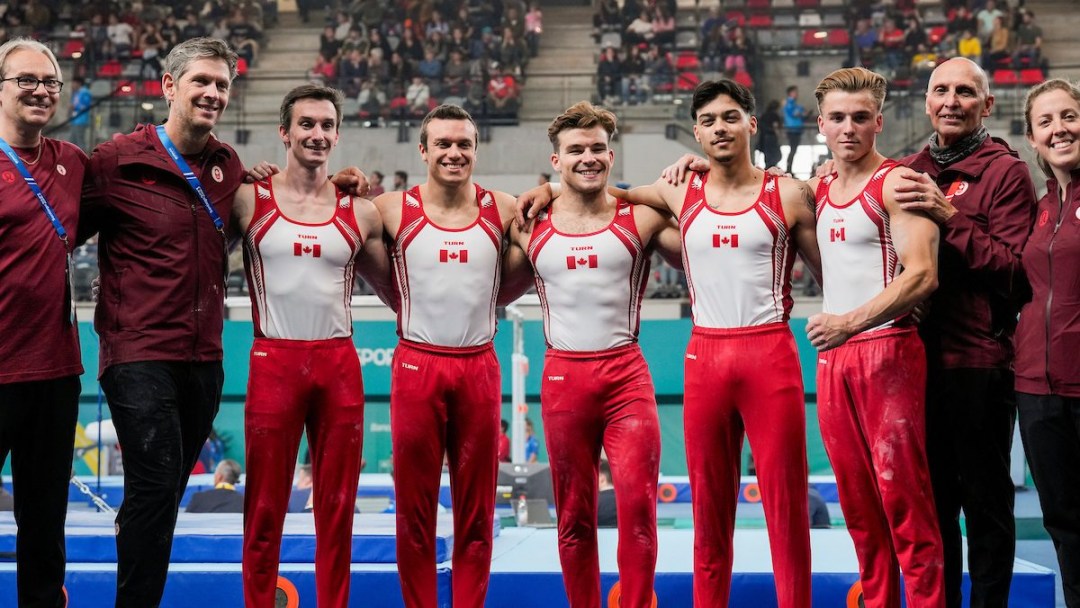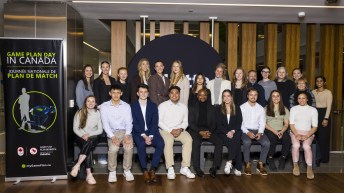One big goal this summer for Canada’s first Olympic men’s gymnastics team in 16 years
The Canadian men’s artistic gymnastics team that will take to the floor at the Olympic Games in Paris this summer has one singular goal in mind – make the team final. It’s a feat that no other Canadian men’s artistic gymnastic (MAG) team has managed to accomplish before.*
Qualifying for Paris 2024 via a fourth-place result in the qualification round for the team event at the 2023 FIG Artistic Gymnastics World Championships in Antwerp, Belgium this past October, the team went on to finish seventh in the final – making their Olympic dreams a reality and their ultimate team goal seem achievable.
“When I got off the floor and I hugged everybody on the team, it was a very emotional moment,” Félix Dolci reflected a couple months later. “We worked every single day for almost two years for this specific moment in time. We wanted this so bad and once it was done, you could tell that everybody had that weight off their shoulder. We could finally say ‘We are going to the Olympics as a team.’”
“We knew we had a strong team and that we could make it, but actually making it meant the world,” said veteran team leader René Cournoyer. “I went to the last Olympics by myself but doing it with the whole team is an entirely different level of happiness and accomplishment.”
As Canada’s lone MAG representative at Tokyo 2020 after the team failed to qualify for the Games for the third straight Games (Canada lasted fielded a MAG team at Beijing 2008), Cournoyer knows well the heartache of not being able to pull it all together to gain that coveted team spot. As a key figure on the MAG national team since 2015, he’d been part of the unsuccessful qualification efforts for Rio 2016, as well.
“When I started, for Rio, the guys were almost at the end of their careers and I was barely starting. They weren’t taking it easy, but they were surfing a little bit on their previous success. When they retired, that left a gap in the national team and that allowed the younger guys to show up and they were really working hard, but they weren’t as experienced. We had one or two good guys, but not enough to have a whole team, so by the time we got to the Tokyo qualifiers, we had good fitness, and a little bit of experience, but that just didn’t cut it,” remembers Cournoyer of that time in his career.
As the team entered the qualification phase for Paris 2024, they now had a combination of experience and skills, and thanks to National Team Head Coach Ed Van Hoof, perhaps most importantly, they had new belief in their ability to perform.
As the MAG Technical Director/Head National Coach for the British Men’s National Team for many years, and an Olympic gymnast himself, Van Hoof was the architect for that program’s phenomenal rise from being ranked 23rd at the 2003 World Championships to winning a team bronze at the London 2012 Olympic Games less than a decade later.
When he joined the Canadian team in July 2018, he knew the athletes were capable of delivering high level gymnastics. What they lacked was consistency in their performances and a dedication to performing at the highest levels.
“That first year, I honestly thought in the first two years that they would be capable of qualifying for the top-12 in the two world championships that we had leading into Tokyo,” said Van Hoof. “They had very good lines on the apparatus and, if anything, they were just lacking perhaps a little bit of difficulty. But it became clear that they also lacked consistency in performance and that was their biggest downfall because their gymnastics was really of quite a high level and very clear.”
Van Hoof remembers asking the team: “How many of you have ever been to a major competition and hit six for six routines?” The answer that came back was pretty much zero.
“They were always making a major error somewhere in every competition they’ve ever done. And so, I said: ‘You’re an all-around athlete. The job is to go there, do six events, hit six routines. They may not be the highest and the best that you could do, but you hit six routines – that’s what competing is about,’ and that was an infrequent event,” remembers Van Hoof.
Van Hoof implemented a couple key phrases to the team: “every go counts” and “competition reflects training”.
“’Every go counts’ means that you don’t just get on an apparatus and have a swing just for the sake of it. There has to be some purpose to every go; something that they have to focus on within their mental approach. And with ‘competition reflects training’ – it means if you’re not doing it in training, you can’t suddenly expect to do it in competition with the added pressure, or different environment and expectations.”
When the team of Cournoyer, Zachary Clay, Dolci, William Émard, and Jayson Rampersad celebrated their Olympic-qualifying result in Antwerp, they did it after hitting all four routines on an apparatus that hasn’t always been their friend – the pommel horse — and putting up big numbers and clean routines consistently across the board. Clearly the renewed focus on quality and consistency has had an impact on the team.
With less than two months to go until Paris, the athletes that will make up Canada’s Olympic MAG team are gearing up for the Canadian Championships taking place June 6-8 in Gatineau, Que. The top two athletes in the all-around after the second day of competition will book their tickets for Paris, with the remaining three athletes to be determined based on their performances across the six apparatus during the two-day competition.
Cournoyer is considered a top contender for the team with his many years of international competitive experience, as is Dolci, who is fresh off his gold-medal winning turn in the all-around at the 2023 Pan American Games in Santiago, Chile – something no Canadian man had achieved at the Pan Am Games since 1963.
A peek at Émard’s Instagram shows that he is recovering well from a torn bicep muscle sustained in March, while Sam Zakutney, the Canadian all-around champion in 2019, also appears to be back in top form after recovering from a shoulder injury a year ago. Eyes will also be on Clay and Rampersad, who won gold and silver, respectively, on pommel horse in Santiago.
“As a team, I think we’ve gotten enough experience to expect the unexpected and face it whenever it arises,” said Cournoyer. “We have to go one step at a time. Training every single day, one day at a time. Making it to nationals, doing what we have to do at nationals, and then thinking about Paris. It’s our coaches’ job to think about long-term preparation, and it’s our job as an athlete is to make sure we make it in one piece. Listen to our bodies and be mentally prepared to perform well when it matters.”
(*History lesson: The team final as a standalone event made its debut at the 2000 Olympic Games. Prior to that, team medals were awarded based on final rankings from the qualification rounds. Canada finished a high of seventh in this format at the 1984 Olympic Games in Los Angeles – a Games that was boycotted by typically strong gymnastics nations from the Eastern Bloc.)


